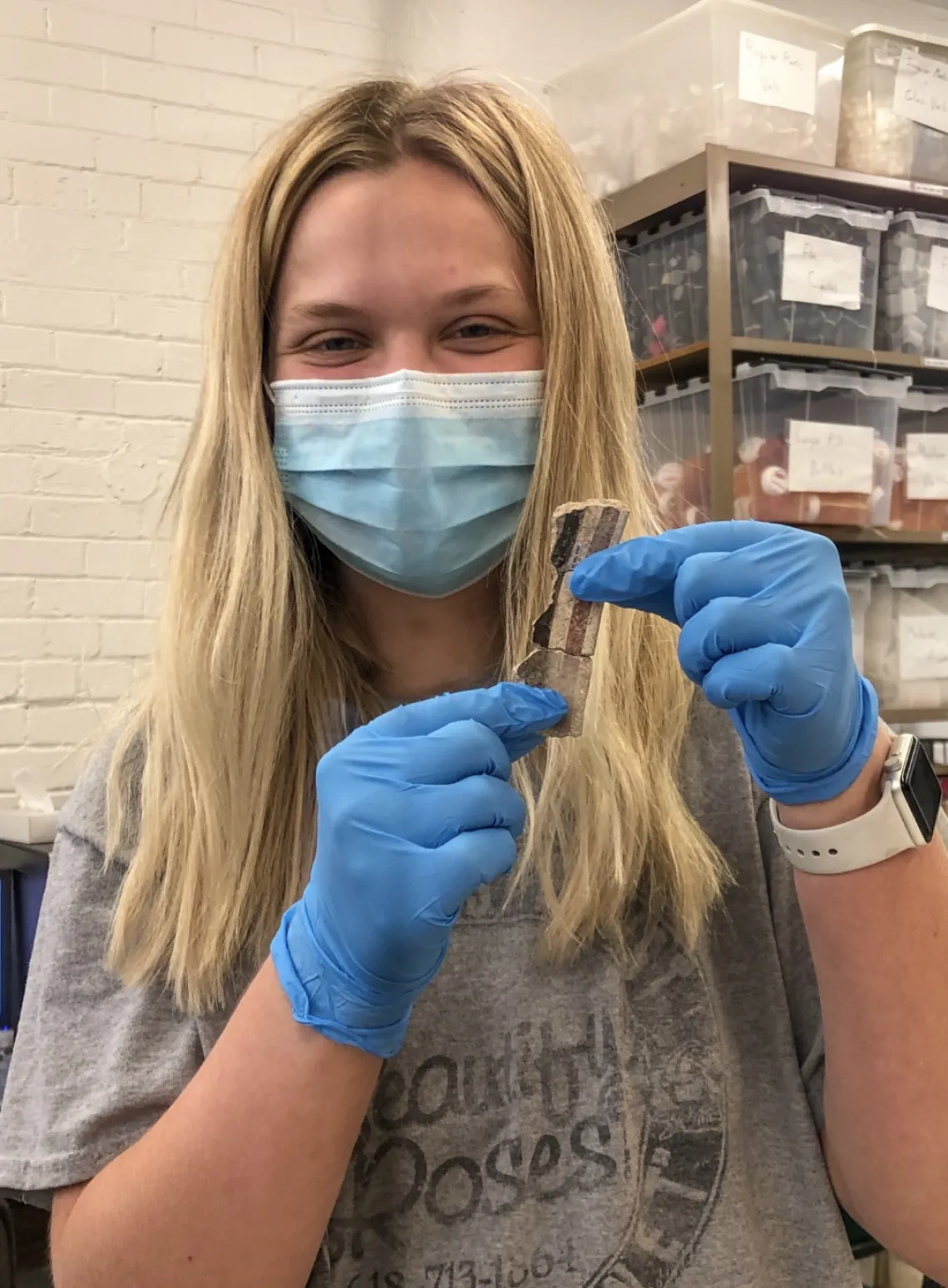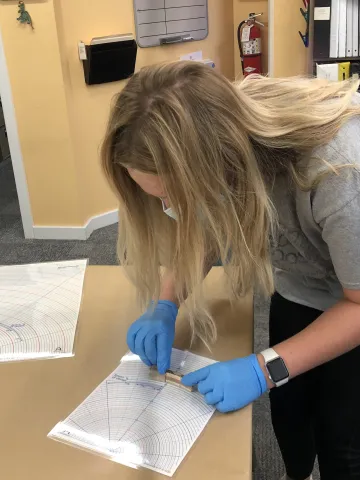
Emily Hale holding the sherds that comprise Vessel 1, 2009-0789-26, 2009-0789-28, and 2009-0789-34. All three sherds refit.
By Emily Hale
ASM Archaeological Repository and School of Anthropology BARA Intern
Spring 2022
Graduating in May 2022 with a double major in Anthropology and Classics, for my last semester I worked at the Arizona State Museum (ASM) Repository as a School of Anthropology Bureau of Applied Research in Anthropology (BARA) intern. I focused on preparing the collection generated at the University Indian Ruin Field School excavation led by Drs. Paul and Suzanne Fish, for in-perpetuity curation. This internship opened up the world of Southwest Archaeology to me. Throughout my undergraduate career, I focused my studies on mostly Classical Archaeology. Throughout the semester, I learned more about anthropological themes that are relevant to cultures and societies in both the American Southwest and Classical Archaeology, such as trade networks, feasting, and rituals. The catalog collection for the University Indian Ruins (UIR) excavation contains three sherds that encompass all of these interests.
Objects 2009-0789-26, 2009-0789-28, and 2009-0789-34 are all pieces of a vessel labeled Vessel 1 (Figure 1). These sherds have a tan color, with decorative red and black lines striping below the rim on the interior curved side. Outside the vessel, geometric line styling can be seen on object 2009-0789-26. Vessel 1 was found in Room 1 of the UIR site. This room contains evidence of being ritually closed. Ritually sealing a room in the Southwest is common and signals the end of the room’s life. This vessel was likely broken prior to the room fill and was scattered throughout different stratigraphic layers.

Emily Hale measuring the estimated rim diameter of Vessel 1 so that this information can be included in the object description for the catalog card.
However, beyond its possible use in feasting, there is much we can still learn from this vessel. Vessel 1 was found in the “Bison room” at the UIR excavation site (Fish et al, 2015). Room 1, or the “Bison room” was a part of a collapsed/sealed room containing the remains of burnt bison bone, an uncommon animal for this region. The provenience of the sherds in the bison room suggests a correlation between Vessel 1 and the bison (Fish et al, 2015). The correlation between the bison and Vessel 1 could be explained in multiple ways. Bison could have been used in the same feast as Vessel 1, and the evidence for this could be within the UIR catalog. Object 2009-0789-10 is a worked blade similar to the ones Native Americans used on the Great Plains for buffalo hunting. The presence of this blade in Room 1 suggests the bison was slaughtered on site, rather than being brought into the (now) Tucson area, having already been killed.
This vessel’s connection between potential feasting, ritual, and trade networks has been the first time I have worked with an object from an archaeological standpoint examining these themes in practice. Like with much of my work at ASM, I have learned all sorts of aspects of archaeological practices outside the classroom. This ranges from examining student excavation forms to describing objects and thinking critically about their uses. These were things I had come into this internship hoping I would learn, what I wasn’t expecting to learn was all of the multiple organizational tools the Repository uses to stay on track. I was able to look at different projects that ASM Repository works on and their similarities and differences from my project. The monthly BARA meetings in which all teams provided progress updates, introduced me to a whole world of Applied Anthropological projects demonstrating in real-time how problems such as disruption of coast lines and local energy equity problems can all be researched with tools rooted in Anthropology. While I still favor the archaeological context, I have gained a huge appreciation and understanding of the larger world of Anthropological research today.
References Cited
Fish, Suzanne K, Paul R Fish, Mark Elson, Maren Hopkins, Mathew Pailes
2015 University of Arizona Archaeological Field School University Indian Ruin Preliminary Report, 2010-2014. School of Anthropology University of Arizona
Grimstead and Bayham, F. E.
2010 Evolutionary Ecology, Elite Feasting, and the Hohokam: A Case Study from a Southern Arizona Platform Mound. American Antiquity, 75(4), 841–864.
Mills Barbara
2007 Performing the Feast: Visual Display and Supra Household Commensalism in the Puebloan Southwest. American Antiquity, 72(2), 210–239.





